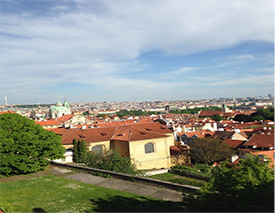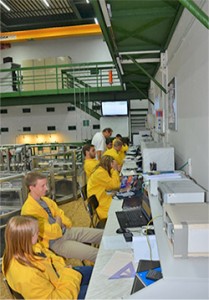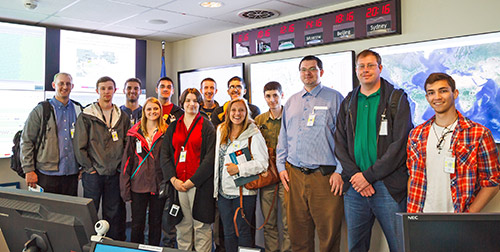Nuclear Engineering in Prague, 2015
May 9–10, 2015
 Everyone woke up early on May 9 and got ready for their early morning flights to Prague. Everybody was excited to explore Prague, learn about the culture and work on the VR-1 test reactor. After a long day of traveling, we all finally arrived in Prague around 10 AM.
Everyone woke up early on May 9 and got ready for their early morning flights to Prague. Everybody was excited to explore Prague, learn about the culture and work on the VR-1 test reactor. After a long day of traveling, we all finally arrived in Prague around 10 AM.
After arriving at the airport, our next stop was Castle Residence Hotel, which was located in Praha 8 in Libeň. To get to the hotel, we all had to learn to use the bus and metro systems of Prague. After arriving at the hotel, we found out that our rooms were not ready, so the desk clerk offered us to use the putt-putt golf course.
After about one hour, the rooms were ready so we all settled into our rooms and went out to eat lunch. During our exploration of Praha 8, we stumbled upon a Mexican restaurant called “7 Tacos”. At 6 PM, we all meet up at the hotel restaurant and one of the instructors from Czech Technical University came and talked to us about our schedule for the next two weeks and little bit about the VR-1 reactor.
May 11-13, 2015
The next morning came, and we set out in a small bus for a uranium processing facility a couple of hours away from Prague. Needless to say we were very thankful for the American highway system, as the Czech roads were quite bumpy. We arrived at the facility and toured the entire plant.
Unfortunately, we were unable to actually go into the mine for safety concerns, but we saw the rest of the process. On the way back, we stopped at a restaurant in a small village, ate another delicious meal, and even got to mess around a bit on the playground in the backyard. That was our only scheduled activity for the day, so we all went into downtown Prague after we returned and walked around for a while.
The old town was exceptionally beautiful, and we saw sights such as the astronomical clock and the Charles’ Bridge. We actually walked around so much that we stumbled upon one of the few restaurants recommended to us by Czech students that are at UT.
The next day, we visited a nuclear power plant located in Temelin. It was very interesting to see the differences between the nuclear power plants from the US and those in the Czech Republic, but there were many similarities as well. After lunch, we visited the Budweiser Budvar Brewery and were able to see the entire brewing process of Budweiser beer (not to be confused with the American Budweiser).
The following morning was spent at the Czech Nuclear Research Institute—Řež. This was very similar to Oak Ridge, and we were able to see multiple research reactors and various other scientific breakthroughs. They even let us use mechanical arms to move samples in radiation-proof boxes called hot cells.
That afternoon, we went to Prague Castle. We toured the cathedral and were able to climb to the top of one of the bell towers. From the top, all of Prague could be seen, and it was rather breathtaking.
May 14-16, 2015
The next day, we woke up early and took a train to Vienna, Austria. It took about 4-5 hours to go from Prague to Vienna. The train ride was very smooth and comfortable. After we got to Vienna, we took metro to the hotel and checked in. After resting for couple of hours, we took a metro to Belvedere Palace. We saw some great artwork and after that we went to a restaurant near the Belvedere Palace to eat Vienna’s famous schnitzels. The following morning, we visited IAEA, CTBTO and St. Stephen’s Cathedral. First, we took a tour around IAEA and talked about nuclear safeguards. We then went to CTBTO for a talk on nuclear weapons and technologies used for detecting nuclear explosions before eating lunch with IAEA and CTBTO employees. After touring IAEA and CTBTO, we took the metro to St. Stephen’s Cathedral. After all of our activities and a nights rest,we took the train back to Prague.
May 18-24, 2015
 After a week of cultural experiences and sightseeing, it was time to start the series of experiments at VR-1. We performed eight experiments, one of which contained hands-on operation of the VR-1 reactor.
After a week of cultural experiences and sightseeing, it was time to start the series of experiments at VR-1. We performed eight experiments, one of which contained hands-on operation of the VR-1 reactor.
Besides the individual operation of the reactor, we also conducted experiments for neutron detection, reactor dynamics, delayed neutron detection, reactivity measurements, control rod calibration and criticality experiments. These experiments were conducted in five days, and therefore we performed two experiments most days. The week in the lab was tough, but each experiment targeted different concepts so it was still fun and interesting. At the end of the week, the students and some of the instructors from the university went for farewell dinner at Zlatý klas.
One of the most interesting experiments was the Approach to Criticality. We divided into six pairs for a competition. We had graph paper and a pencil and used linear extrapolation to find the height of a control rod that would bring the reactor to a critical state at the given conditions. The final height of the control rod was 479 mm, and the groups’ estimates fell between 470 and 478 mm.
